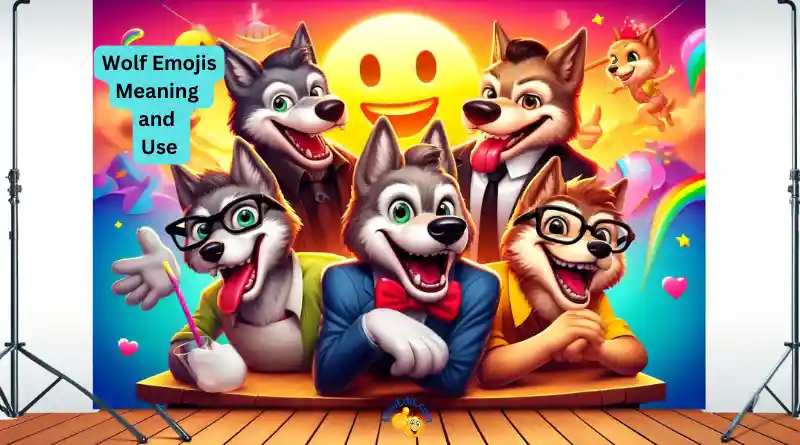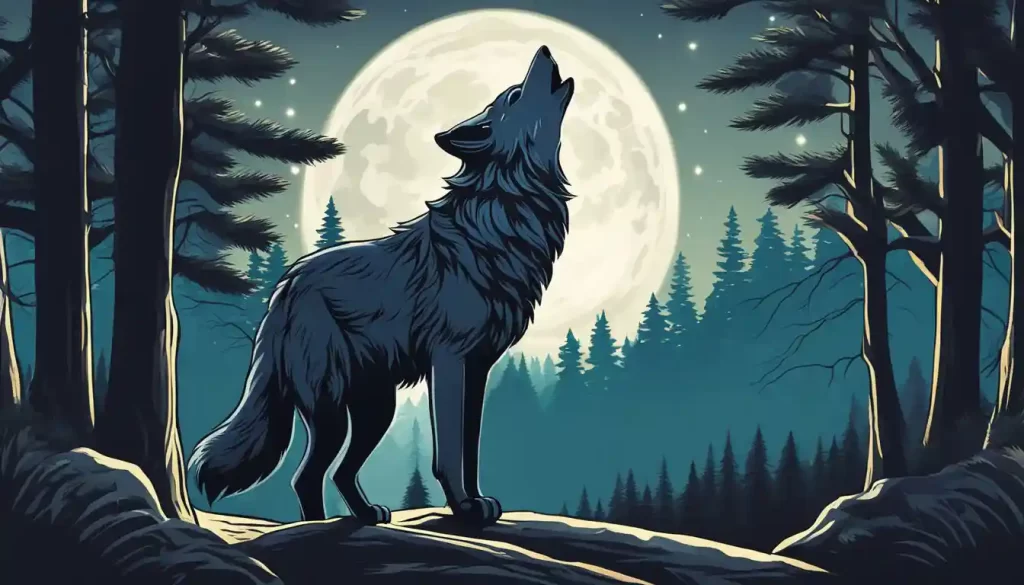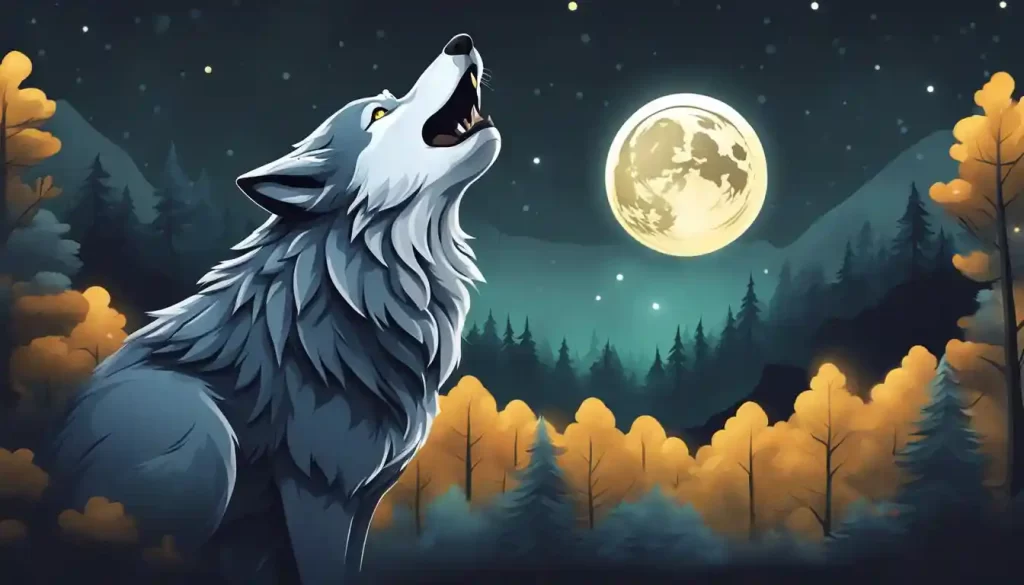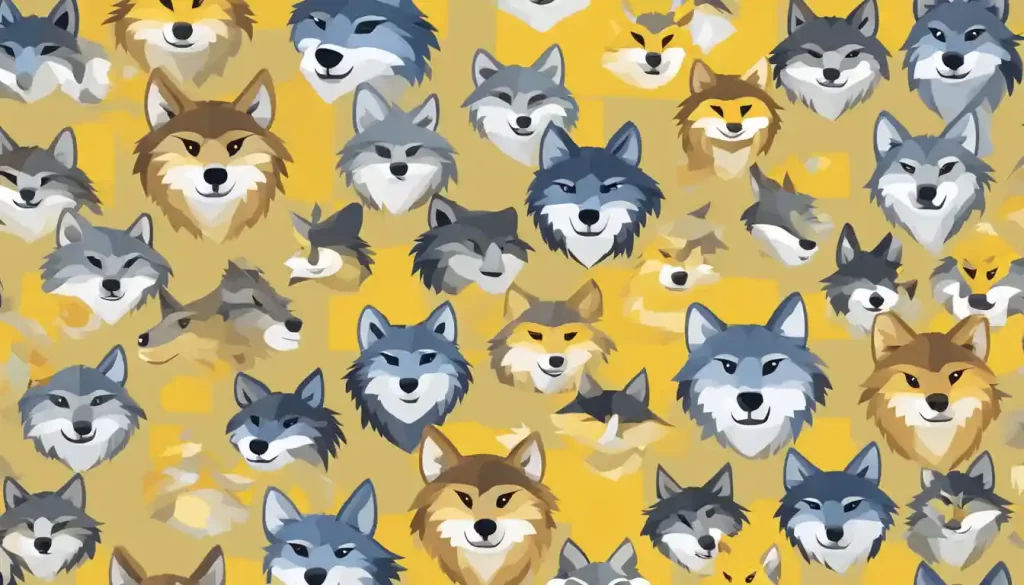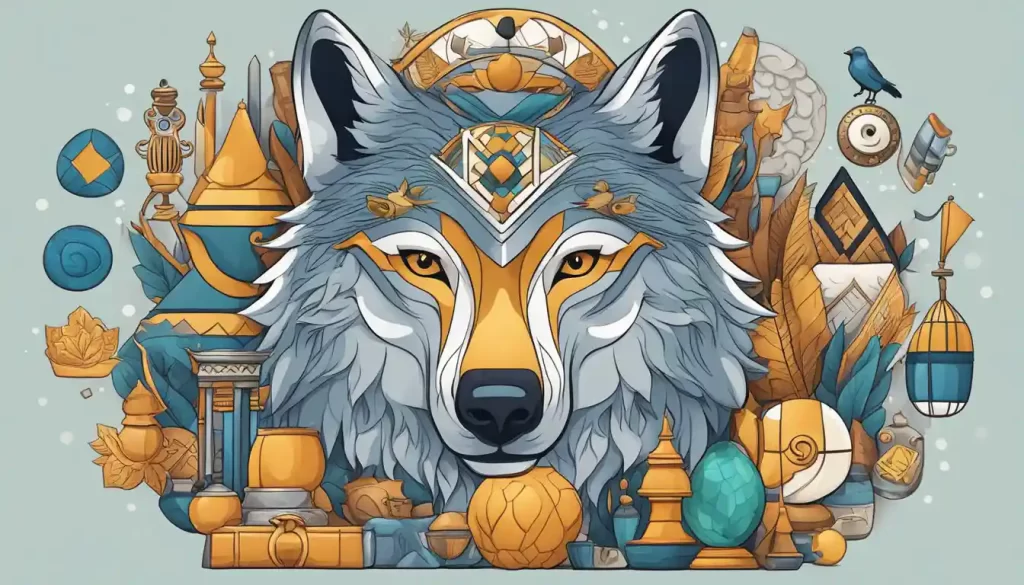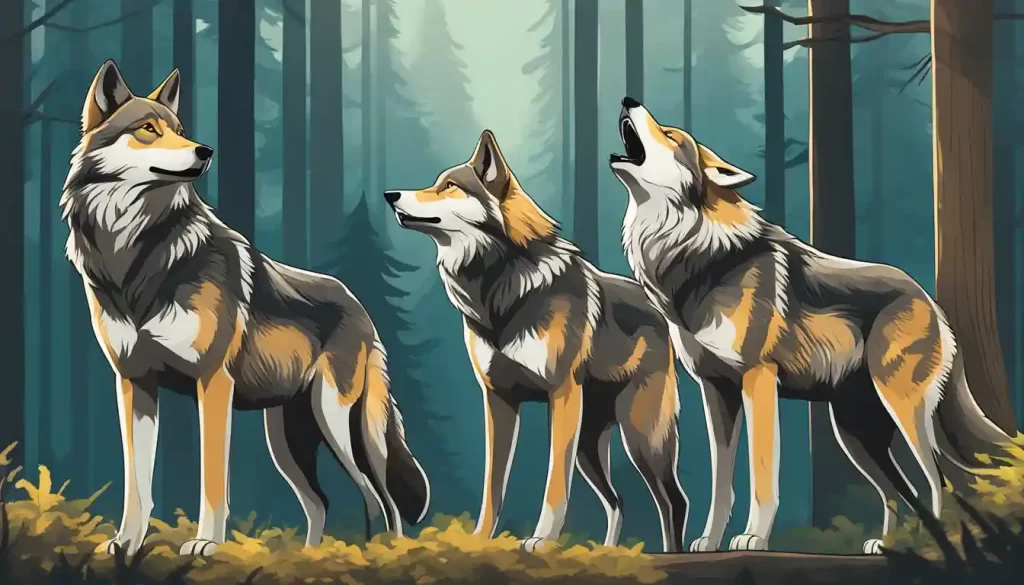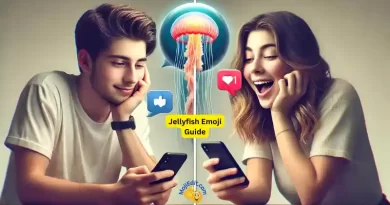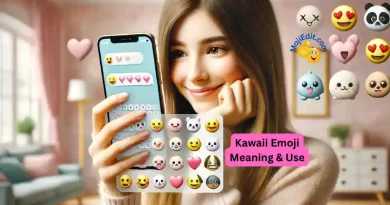Wolf Emoji 🐺 in Action – Guide to Meaning and Use
Hey there, digital world wanderers! 🌐 Emojis? They’re the zest in our text, the wink in our chats, and our fave wolf emoji 🐺 is howlin’ its way to emoji stardom. Wolfie is rockin’ those sharp ears and that sassy stare, this little icon is more than just a button on your keypad. Of all the animal emojis it is one of my favorites. It’s the spirit of the wild, wrapped in a digital hug. Whether you’re a solo mover shakin’ up the status quo or rollin’ deep with your pack, the wolf emoji is your go-to for vibin’ with that untamed heart of yours. So go ahead, let your texts run wild with meaning, both in the open plains and the hidden depths of our online jungle! 🌲💬
Over time, the design of the wolf emoji has seen a range of interpretations across different platforms, each adding their own stylistic flair to this iconic creature. These designs reflect the diverse attributes associated with wolves, such as loyalty, intelligence, and freedom. Furthermore, the use of the wolf emoji transcends simple imagery; it integrates into programming through various codes and technical aspects—allowing for creative expression in app development and web design. As we continue to evolve in our digital communication, the wolf emoji adapts, reflecting both cultural impacts and changes in our understanding of wolves themselves.
Key Takeaways
- The wolf emoji epitomizes both the literal animal and a range of symbolic meanings.
- Designs of the wolf emoji vary by platform, enhancing its expressiveness.
- Its usage extends into programming and reflects cultural significance.
Origin of the Wolf Emoji
As we dive into the history of our favorite 🐺 Wolf Emoji, let’s explore how it evolved from an idea into a symbol we all love to use. Starting with its early development and moving onto its incorporation into the Unicode Standard, there’s a lot to uncover about this popular character.
Early Development
Initially, the wolf emoji was conceived like any other digital icon—through a creative process aiming to capture the essence of a wolf in a simple, visual format. Designers took inspiration from the animal’s recognizable features, such as the pointed ears, sharp muzzle, and intense eyes. This depiction needed to resonate across cultures, embodying not just the animal but also the traits associated with it: independence, strength, and loyalty.
Unicode 6.0 Inclusion
Advance to 2010, and our wolf friend makes a significant leap. The wolf emoji’s path crossed with the Unicode Consortium, the governing body in the digital encoding space. With the release of Unicode 6.0, the wolf emoji was officially introduced into the Unicode Standard. This inclusion meant that the emoji could be widely used and recognized across different platforms and devices. Consequently, the 🐺 emoji became a go-to for expressing ideas linked with wolves, from wilderness and nature to metaphors of communal strength or individual freedom.
🐺 Mastering the Wolf Emoji: Express Yourself Wildly
Hey there, emoji enthusiasts! 🤩 Are you ready to take your text game to the next level with the fierce and fabulous wolf emoji? Let’s dive into the do’s and howl’s 🌕 of using this wild creature in your daily digital adventures.
🎭 Conveying Emotions with the Wolf Emoji
Sometimes, a simple LOL or 😂 just doesn’t cut it. That’s where our furry friend comes in. Feeling brave and ready to take on the world? Drop a 🐺 to show your strength. Want to tell your squad you’re ready for a night out? A wolf emoji adds that touch of pack pride to your group chat.
🤔 Puzzled? Throw in a Wolf!
Whenever you’re in a playful mood or feeling a bit mischievous, sneaking a wolf emoji into the conversation can add that ‘I’ve got a trick up my sleeve’ vibe. It’s like saying, “Guess what I’m planning?” without spilling the beans. 😉
🌲 Nature Calls
Are you chatting about your weekend hiking trip? Why not let the wolf emoji lead the way? It’s perfect for those moments when you want to share your love for the great outdoors. It’s not just an emoji; it’s a call to adventure!
🚀 Taking Creative Texts to New Heights
But the fun doesn’t stop there. Mix up the wolf emoji with others to create a story. A moon 🌜, a tent ⛺, and a wolf 🐺 can tell a tale of a camping trip that turned into an unexpected adventure.
🎨 Get Artsy
Feeling artsy? Combine the wolf emoji with a palette 🎨 to show off your wild strokes of genius on canvas. It’s a great way to say, “Check out this masterpiece I created!”
🙌 Celebrating with the Wolf Emoji
Finally, when your friend aces a test or nails a job interview, send a wolf emoji their way. It’s like a high-five with a wild twist, saying, “You’re as powerful as a wolf!”
So there you have it! The wolf emoji isn’t just for animal lovers. It’s versatile, it’s expressive, and it’s a whole lot of fun. Start sprinkling your conversations with a dash of the wild. Go ahead, give it a try and watch your texts transform! 🐺🚀
What’s your favorite way to use the wolf emoji? Drop a comment and let me know! Keep it cool, keep it wild, and until next time, happy texting! 🌟
🐺 Wolf Emoji in Action: Texting Scenarios
Check out these fun examples of how to weave the 🐺 wolf emoji into your daily texts!
| Scenario | Text Without Emoji | Text With Wolf Emoji |
|---|---|---|
| Showing excitement for a weekend hike | “Can’t wait to explore the trails this Saturday!” | “Can’t wait to explore the trails this Saturday! 🐺🌲” |
| Congratulating a friend on a job well done | “You really nailed that presentation today!” | “You really nailed that presentation today! Total alpha move! 🐺✨” |
| Planning a night out with friends | “Are we still on for movies tonight?” | “Pack gathering tonight? Movies under the moon? 🐺🌕🎬” |
| Expressing independence | “I like spending time on my own sometimes.” | “Sometimes I’m all about that lone wolf life. 🐺💪” |
| Sharing a moment of mischief | “I’ve got a surprise for everyone at the party!” | “I’ve got a surprise for everyone at the party! 🐺😏” |
| Reacting to a spooky story | “That story gave me chills!” | “That story gave me chills! 🐺🌘 Got any more?” |
| Discussing a favorite book | “I love the wilderness theme in that book.” | “I love the wilderness theme in that book. It’s like it’s written for us wolves. 🐺📖” |
Feel free to get creative and let the wolf emoji help express your wild side in texts! 🎉📱
Discover the Emoji Pack: Wolf Emoji’s Wild Companions 🐾🌲
Emojis are all about expressing emotions and setting a scene, and the wolf emoji often runs in a pack with other related symbols. Let’s explore its most common companions that add context and color to your conversations.
🌕 Full Moon Emoji
When the night sky is clear, and the full moon rises, our wild wolf comes out to howl. Pair the wolf emoji with the full moon emoji to evoke scenes of mystique or to plan an evening get-together that’s bound to be out of the ordinary.
🐾 Paw Prints Emoji
Whether you’re a lover of all furry friends or sharing tales of your own pets, the paw prints emoji walks alongside the wolf to show your animal appreciation. It’s perfect for stories of hikes, animal tracks, or just cuddling with your pet at home.
🦊 Fox Emoji
Cute, cunning, and just a bit wild, the fox emoji often teams up with the wolf to bring a touch of woodland wit to your messages. Use it when you’re feeling clever, or to suggest a fox-like friend is up to their usual tricks.
🌲 Evergreen Tree Emoji
No wolf’s habitat is complete without the forest it calls home. The evergreen tree emoji brings nature into your chat, perfect for plans that involve camping, nature trails, or just a deep appreciation for the great outdoors.
🔥 Fire Emoji
Campfires and wild tales go hand-in-hand with our wolf emoji. Use the fire emoji to ignite excitement about upcoming camping trips or evenings spent sharing stories under the stars.
🏕️ Camping Tent Emoji
Ready for an adventure? Combine the wolf emoji with a tent to signal your next outdoor excursion. It’s great for coordinating group trips or just expressing your love for sleeping under the stars.
These are just a few emojis that share the same wild spirit as the wolf. Mix and match to create your own emoji tales and let the digital wilderness come alive in your chats! 🐺🌟📱
Design Evolution
When we look at the journey of the wolf emoji, it’s clear that tech giants like Apple and Google have put their unique spin on it. Over the years, these adaptations have evolved, showcasing the advancements in digital art and design attitudes.
Apple’s Interpretation
The wolf emoji on Apple devices started off as a detailed and realistic representation. Over time, Apple has refined the image to exhibit the wolf in a more stylized and friendly light. More recently, their design emphasizes a gray wolf with soft fur textures, maintaining the iconic pointed ears and attentive eyes. The subtle changes over the years include alterations in color tone and expression, catering to the diverse use of emojis in conveying emotions in digital communication.
Google’s Adaptations
Google, on the other hand, has experimented with several design overhauls for its wolf emoji. Initially, Google’s rendition had a more cartoonish appearance, with a bold outline and less concern for realistic proportions. The progression in design eventually led to a more nuanced and expressive wolf, harnessing subtle gradients for a three-dimensional look. Additionally, Google incorporates various neutral to friendly expressions, giving users a range of emotional cues to choose from when using the wolf emoji in their messages.
Although design approaches vary between platforms, the essence of capturing the wolf’s distinct features remains foundational to both Apple and Google’s designs. Their commitment to evolving the wolf emoji depicts the importance of these tiny digital icons in expressing our human thoughts and emotions.
Wolf Emoji Across Platforms
When we chat with friends or update our status, the wolf emoji brings a wild touch to our messages. Each platform offers their own twist on this canine symbol, and it’s fascinating to see the differences.
Variations on iPhone
On iPhone, Apple’s take on the wolf emoji shows a detailed grey wolf with a calm but alert expression. The designers have captured its essence with pointy ears and a thick coat, ensuring that it stands out in our texts. It’s perfect for conveying a sense of independence or team spirit when we want to say that we’re part of a close-knit ‘wolf pack’. Frequently, it’s also used when we’re feeling a little wild or want to express our admiration for someone’s loyalty or courage.
Representations on Android
Switching over to Android, the Google-designed wolf emoji takes on a more playful appearance. While still recognizable, Google’s version tends to have a friendlier vibe, often looking like it’s slightly grinning. This variation certainly adds a bit more cheer to our conversations, especially when we want to show our goofy or friendly side. Additionally, depending on the Android version, the shade of the wolf’s fur can vary, but it generally maintains that iconic grey hue with piercing eyes that we associate with wisdom and guidance.
Symbolism and Usage
The wolf emoji 🐺 is not just a picture; it’s a symbol packed with meaning that tells a story. When we use this emoji, we’re tapping into powerful themes of freedom, community, and instinctual power.
Lone Wolf Concept
The ‘lone wolf’ concept is a celebrated part of wolf symbolism. When we send a 🐺 emoji, it could reflect our fierce independence or convey a sense of self-reliance. This emoji epitomizes the spirit of someone who walks their own path, not necessarily because they’re isolated, but because they choose to. In digital conversations, it highlights that we, like the lone wolf, are capable of thriving on our own.
Pack Mentality
Conversely, wolves are known for their wolf pack structures, symbolizing unity and teamwork. Using the wolf emoji 🐺 can suggest our value in collaboration and loyalty within a group. It can also represent our protective instincts towards those we care about or signal our role as part of a tight-knit community. This emoji encapsulates the essence of the ‘pack mentality,’ underlining the importance of social connections and shared goals.
Technical Aspects
When we talk about the technical aspects of the wolf emoji, we dive into how it’s integrated and represented across various coding languages and platforms. We’ll explore how this emoji is coded into systems using shortcodes and how it is encoded for HTML and URLs.
Shortcode Implementation
In numerous platforms, such as GitHub and Slack, emojis can be added by using a shortcode, which is a word or phrase wrapped in colons. For the wolf emoji, the shortcode typically resembles :wolf:. When this shortcode is input, the platform recognizes it and replaces it with the corresponding emoji image.
In programming languages, implementing emoji shortcodes can vary. For instance, in Python, you might use a library like emoji to convert shortcodes to the actual emoji. In JavaScript, arrays or objects are often used to map shortcodes to Unicode, while in CSS, content with attr() may be used to display emojis when a shortcode is detected in the text.
HTML and URL Encoding
HTML encoding for the wolf emoji involves using the numeric character reference based on Unicode, which for the wolf emoji is 🐺. This means when you insert this code into an HTML file, the wolf emoji will be rendered by the browser.
For URL encoding, which allows emojis to be sent in web addresses and server requests, the wolf emoji is percent-encoded. Each Unicode character is converted into a percent sign followed by two hexadecimal values. The wolf emoji would be encoded as %F0%9F%90%BA, ensuring proper transmission over the internet.
Handling emojis like the wolf emoji in technical implementations requires understanding these details. Whether it’s adding flair to a website or transmitting data, getting acquainted with these codes and encodings is vital. After all, when we nail the technical side, those little icons light up our screens and conversations perfectly! 🐺😉
Copy and Paste the Wolf Emoji 🐺
Ready to add a wild twist to your messages? It’s super easy to use the wolf emoji anywhere you want to express your adventurous side or just spice up your digital conversation. Just follow these steps to copy and paste the wolf emoji:
- Click the “Copy” button below to copy the wolf emoji to your clipboard.
Emoji Copied! 🐺
- Head over to where you’d like to show off your wolfish charm and right-click on the text field.
- Select “Paste” from the menu, or use the keyboard shortcut Ctrl + V (Windows) or Cmd + V (Mac) to get your emoji into the conversation.
And there you go! You’re now ready to add a bit of the wild to your chats with the wolf emoji. 🐺🌲
Emoji Integration in Programming
Emojis have taken their place in our digital communication and are now spicing up the world of programming. They offer a whimsical and visual way of writing code, which can make programming languages more engaging and fun for us developers.
Using Emojis in JavaScript
JavaScript, the language of the web, allows us to integrate emojis in various ways. Whether we’re working on a web application or just playing around with code, emojis can be included directly in our JavaScript files. In HTML, we can place emojis right into the text, like <p>🐺</p>, to display a wolf emoji to our users.
We can also work with emojis in JavaScript by using the unicode representation of the emoji. For instance, the wolf emoji 👩💻 can be included in a string variable like this:
let wolfEmoji = '🐺';
console.log(`Beware of the big bad ${wolfEmoji}!`);
In addition, emojis can be used as keys in JSON objects. This gives us an entertaining way to access data:
{
"🐺": "Wolf Emoji"
}
As we manipulate the DOM using JavaScript, we can style our wolf emoji using CSS, resizing and positioning it to better fit our design vision. With document.querySelector('.wolf').style.fontSize = '2rem';, our wolf emoji can be double its original size!
Emoji Libraries for Python
In Python, libraries such as emoji empower us to include emojis in our projects. This can be a great educational tool, especially when we’re trying to teach coding concepts to teenagers and want to keep their attention.
After a simple installation process with pip install emoji, we can start incorporating emojis into our Python scripts. Here’s how we might print out a cool wolf emoji to the console:
import emoji
print(emoji.emojize('There is a wolf :wolf: in the forest!', use_aliases=True))
These emoji libraries parse the :wolf: alias and replace it with the corresponding wolf emoji. Plus, they give us a vast array of emojis to choose from, opening up a world where our Python applications can be both functional and visually engaging.
In essence, by embracing emojis in JavaScript and Python, we’re enhancing our user interfaces and adding a playful element to our code. Emojis can serve as valuable assets, making our learning and development process a bit more colorful and enjoyable. 🎨🐺🖥️
Cultural Impact
The wolf emoji has woven its way into various aspects of our lives, from representing wildlife conservation efforts to earning a spot in the realm of pop culture. Here, we take a closer look at how this emblem of the wild has left its digital paw prints across different spheres.
Wildlife Conservation
The wolf emoji isn’t just a cool icon on our screens; it’s a symbol that can inspire action for wildlife conservation. When we use this emoji, we’re often reminded of the importance of preserving the habitats of wolves and other wild animals. It acts as a visual prompt in digital communications that can encourage us to think about the broader issues facing nature and wildlife. Social media campaigns often leverage the wolf emoji to spread awareness, making the connection between the digital and natural worlds more tangible.
Pop Culture References
Similarly, the wolf head emoji has clawed its way into pop culture, often used to convey characteristics associated with wolves, such as strength, independence, and pack loyalty. In music, literature, and even on social media platforms, the emoji complements posts related to freedom and wild spirit. Musicians and artists sometimes include the emoji in their posts to convey a sense of rebellion or to hint at a “lone wolf” persona. It’s also not unusual for fans to use the wolf emoji when referencing their favorite celebrities associated with such qualities.
By understanding the cultural impact of the wolf emoji, we see that it’s not only a simple digital image but a carrier of meaning and a bridge between our online presence and our relationship with the natural world and cultural expressions.
Wolf Behavior and Communication
As we dive into the world of wolves, it’s fascinating to see how these majestic animals use various methods to communicate with each other. They have complex social structures and their communication methods are integral to their survival.
How Wolves Communicate
Wolves are highly social animals, and they rely on a combination of vocalizations, body language, and scent marking to express themselves and maintain order within the pack. The most iconic sound a wolf makes is its howl. Wolves howl for several reasons, such as to gather the pack, warn off other animals, and locate members who are far away. Each howl is unique, which helps wolves identify each other.
Moreover, wolves use body language to express a range of emotions and intentions. For instance, they demonstrate dominance by standing tall with erect ears, and submission by crouching or rolling over to expose their belly. Additionally, scent marking, or the act of leaving urine or feces in a location, is used to claim territory and communicate with other wolves. These sophisticated behaviors ensure wolves work together effectively whether they are hunting or taking care of pups.
Comparison with Domestic Dogs
Now, let’s compare wolves with their domesticated relatives, dogs. While both canines share a common ancestor, the communication styles between dogs and wolves have diverged over thousands of years. Pointed ears in wolves are not only a physical trait but also play a role in nonverbal cues. Dogs, on the other hand, have been bred for a variety of ear shapes, which can affect the way they display some signals.
Dogs have developed a range of barks that can indicate anything from excitement to distress, which is quite different from the purposeful howls of wolves. Moreover, domestic dogs are more attuned to human cues and may rely less on scent marking than their wild counterparts. Through domestication, dogs have adapted their communication to better fit with humans, whereas wolves have retained their ancestral methods for intra-species interaction.
Navigating Wolf Emoji Etiquette 🐺👍
The wolf emoji is not just cool; it’s a powerful symbol in our digital conversations. But with great emoji power comes great responsibility! Let’s talk etiquette.
Group Chats and Pack Dynamics
In group chats, the wolf emoji is your go-to for fostering a sense of team spirit. Use it when you’re rallying the crew for an event or showing support. Remember, it’s all about the pack vibes!
Professional Texts – A Lone Wolf No-No
In professional settings, the wolf emoji might be a lone wolf – it often doesn’t belong. Stick to more traditional communication here unless you’re certain the recipient would appreciate a howl.
Timing is Everything
Timing your emoji use is just like timing a joke – get it wrong, and it falls flat. Drop the wolf emoji when the conversation has a playful or adventurous tone, not in the middle of serious discussions.
Know Your Audience
Your grandma might not get the same kick from the wolf emoji that your best friend does. Consider who’s on the receiving end of your text to make sure your message hits home as intended.
Don’t Overpack It
An emoji speaks a thousand words, so don’t overdo it. One wolf emoji at the right moment can be much more impactful than a whole pack crowding your message.
Get these etiquette tips down, and you’ll be the leader of the pack in no time! 🌟📱
The Future of Emojis
As we look ahead, the evolution of emojis seems unstoppable. With every update, they become more inclusive and representative of our diverse experiences. Let’s explore what we can expect from emoji trends in the near future.
Emoji Trends
Substantial shifts are happening in the world of emojis. For one, we’ve noticed a surge in the use of emojis that blend traditional elements with pop culture. Take the Wolf Emoji, embodying not just the animal but also the wild and free spirit many of us resonate with.
Moreover, emoji diversity is expanding to capture a wider array of emotions, situations, and identities. For instance, recent updates have brought in a wider variety of family structures and skin tones, ensuring that everyone feels represented. We’re also seeing emojis that are adaptable to the latest global trends and conversations – from climate change to social movements.
Emojis are also becoming more interactive and dynamic. Imagine reacting to a message not just with a static image but an emoji that conveys emotion through movement. Yes, animated emojis are on the rise, making our digital conversations more vibrant and expressive.
In terms of customization, the future looks bright. The possibility of crafting your own emoji, tailoring it to your outfit, mood, or the weather outside, is an exciting prospect. This personalization would make digital communication even more nuanced and personal.
Finally, accessibility is key in the upcoming emoji designs. Emojis are branching out to include symbols for people with disabilities, promoting inclusivity and awareness at every turn.
So, as we continue to weave emojis into the fabric of our daily communication, we can anticipate a colorful and inclusive array of emojis that cater to every facet of human expression. 🌟👾✊🌎👩👩👦
Frequently Asked Questions and Answers
When a girl sends a wolf emoji, she might be hinting at her fierce independence or showing her admiration for someone’s strength. It could also be her way of saying she’s ready to have a fun and adventurous chat.
On dating platforms like Tinder, a wolf emoji can serve as a playful indication of someone having a strong personality or being incredibly charismatic. It’s a fun and flirty way to express that someone is interested in the mysterious and the bold.
Slipping a wolf emoji into your message often mirrors traits associated with the animal. Depending on the context, it may exude a sense of loyalty, strength, or independence. However, since emojis can be highly subjective, it’s also about the vibe you want to convey.
Common emojis used with the wolf include the full moon, paw prints, fox, evergreen tree, and fire emoji, each adding different contexts to the message.
While the wolf emoji is broadly understood, its interpretation can vary between cultures, so it’s important to consider the audience when using it.

